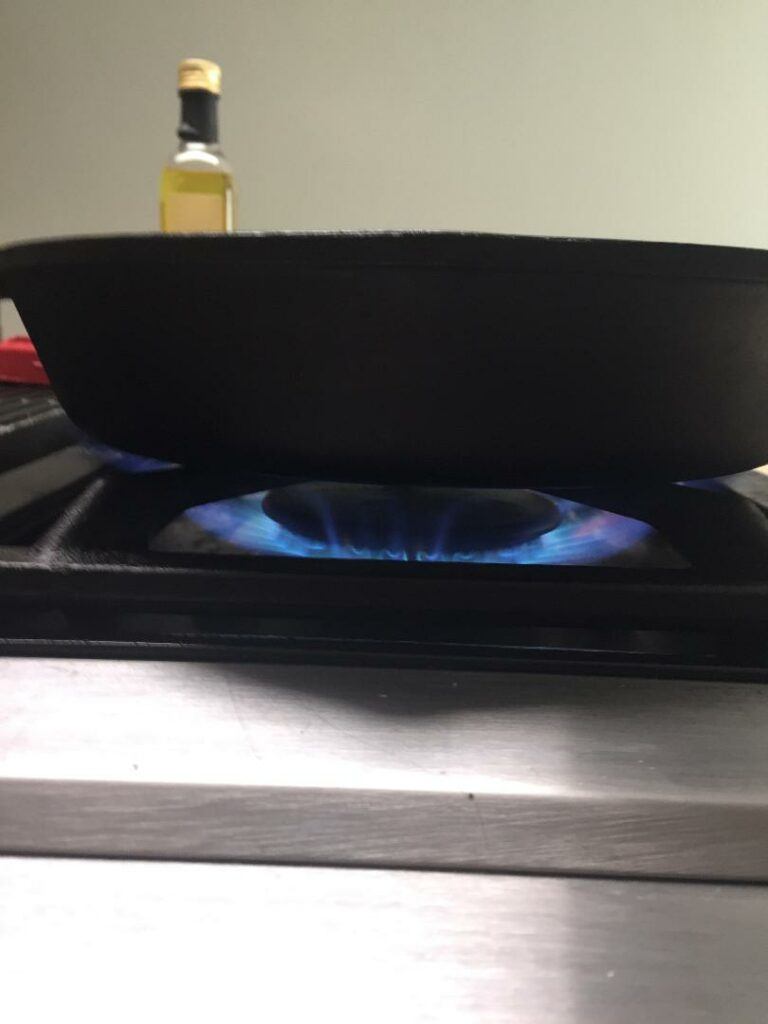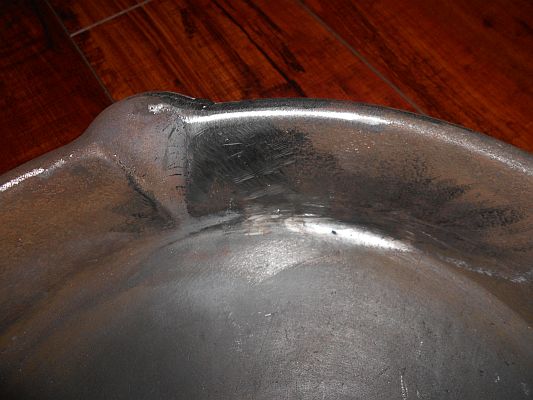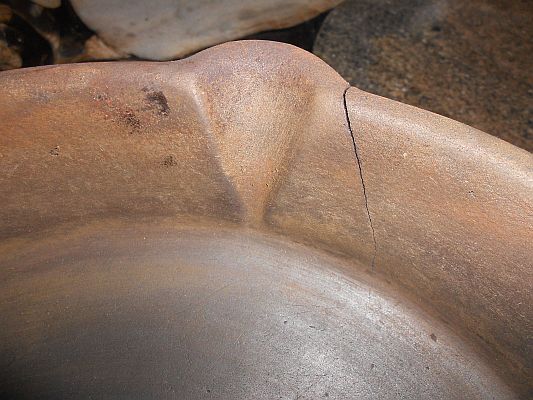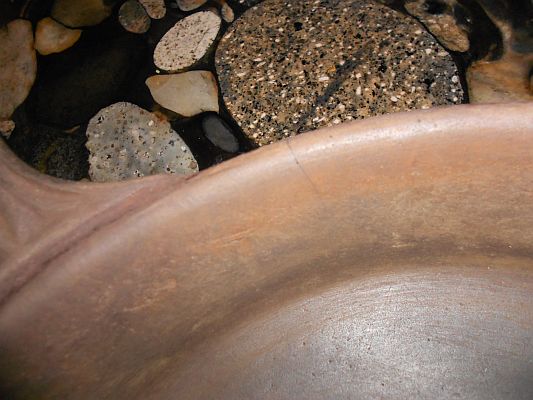Are you asking, “Why did my cast iron pan crack?”
What causes cast iron to crack anyway?
Can you fix it? Or do you have to throw it away?
What about using it with the crack or will the crack only get worse and break?
How do you even know if your pan has a crack?
These are all great questions.
So, keep reading to find the answers.
Table of Contents
What Causes Cast Iron to Crack?
There are several reasons that a cast iron pan might crack. But the two most common reasons are thermal shock or thermal fatigue. Shock involves a sudden temperature change, and fatigue happens over time through the weakening of the pan. Three other reasons include heating your pan too quickly or unevenly, physical impact, and the manufacturer’s defect.
1. Thermal Shock
The definition of thermal shock is “a sudden temperature fluctuation causing stress in an object or substance.”
One of the reasons your pan might crack is because the temperature changed rapidly.
Cast iron is brittle and therefore susceptible to cracking.
For example, if you run cold water in your hot pan, the impact of the cold water will cause thermal shock in the hot pan, and it may crack.
Cracking because of sudden temperature changes is also true of other hard, brittle materials such as glass or ceramic. Even ice falls in this category.
Every morning I brew tea and pour it over ice. The ice immediately cracks.
The opposite is also true. Suddenly introducing a cold pan to high temperatures will also cause a thermal shock.
Some sound advice is to allow your pan to cool before rinsing, or at the very least, use hot water if the pan is hot.
I’ve read a few stories on forums of someone cooking the same way they always do, and they suddenly hear a BOOM! They look, and their pan has cracked in two. That is thermal shock leading to failure of the pan.
In this case, the failure is the pan breaking, and it will seem like it happened suddenly, but did it? Or was the pan weakening over time?
2. Thermal Fatigue
Thermal fatigue is similar to thermal shock, except it takes place over a period of time.
It is my understanding that thermal shock won’t always lead to a crack, but it will weaken your iron and make it more vulnerable to cracking in the future.
One thing I learned in my research for this article is maybe I’ve been cooking my bacon wrong. I was preheating the pan, and after it was hot, I would add the cold bacon.
I decided to pose the question on Reddit and see what they thought.
Fortunately, the consensus was that putting a few slices of cold bacon in a hot skillet would not cause thermal shock.
Another thing that might happen is your pan gets a hairline crack that you don’t even notice. It doesn’t affect your cooking right away, but eventually, the crack may widen or lead to failure, making your pan unusable.
3. Heating Too Quickly or Unevenly

Heating too quickly or unevenly was mentioned above because both relate to thermal shock and thermal fatigue.
My motivation for making it its own reason is that every story I read of someone’s pan cracking in two happened while cooking.
Heating too quickly or unevenly seems to be the number one reason for thermal shock leading to failure. In every instance, the person was doing what they always did.
One person said, “It exploded!” And two people said they heard a loud “BOOM!”
My theory is that, although this can happen, it is rare. And if it does happen, you are more likely to write about it on a forum. But that’s just a theory.
More often, you will see a hairline crack that looks similar to a scratch.
4. Physical Impact
You most likely would not drop your cast iron pan on purpose.
And if you do it accidentally, hopefully, there won’t be anything in it.
But it could happen, or maybe it already has.
While dropping your pan is never advisable, you can imagine the impact could damage it.
The handle breaking seems the most likely of any damage, but there is also a possibility your pan will crack.
5. Manufacturer’s Defect
Though the least likely of all reasons, defects in the factory do happen, from what I hear.
Always check your pan when unboxing it for any defects, including a crack.
And remember, the ring test will help you determine if you have a crack or not.
How Can You Test For a Crack in Your Cast Iron Pan?
This video lets you hear how a cast iron pan with a crack sounds.
I decided to test it out on the skillet I use to make breakfast in, the one I am most concerned about having a crack or be on its way to having one. But when I knocked on it the way the guy in the video did, I heard a clear ring. And that means there is no crack!
If you want to test it visually, hold your pan up to the light and check the rim and all the side walls. If the crack is visible, it may look like a scratch.
But, just to be sure, I would go ahead and knock on it too.
Can You Use a Cast Iron Pan If It Has a Crack
If you watch the video, you will see that using a cast iron pan with a crack is possible. But, should you decide to cook in your cracked pan, be aware of the risk. Thermal fatigue is a real thing, and the more you use the pan, the weaker it will become until one day it may crack in two while you’re cooking.
Overall though, the consensus seems to be if your pan has a crack in it, it’s a hazard, and you should throw it away. Are they assuming it can’t be fixed or just that it isn’t worth repairing?
It probably isn’t worth trying to get it fixed in most cases, but if it’s an heirloom or it’s your favorite cast iron skillet, then repairing it may be worth it to you.
There are three possible ways to fix a crack in a cast iron pan:

- You can weld it. Unless you are a welder who understands the unique challenges of welding cast iron, you probably won’t want to do it yourself. And if you take it to a local welder, you will want to make sure they know how to weld cast iron.
- You can take it to a small casting place and pay to have it recast. But it might be hard to find one near you.
- Do it yourself with a product such as JB Weld or Castaloy. By clicking on one of these links, you will find the instructions. Or, to purchase, click one of the links below.
Affilliate Disclosure: I am a participant in the Amazon Services LLC Assocaites Program. If you make a purchase using an affiliate link, I receive a small commission.
Another possibility if it’s an heirloom is to hang it on the wall and proudly display it.
Final Thoughts
Well, that’s about all.
If you were asking, “Why did my cast iron pan crack?” you now have five possible reasons.
If it was suddenly from impact or extreme temperature change, it was a thermal shock.
But thermal shocks can also be minor, causing weakness, but nothing visible. Over time, these minor weaknesses can become a crack and that process is called thermal fatigue.
Most often, it seems, if you’re dealing with thermal fatigue, the crack will happen while you are cooking at a higher temperature.
If you don’t know if your pan has a crack, go ahead and knock on it. The type of ringing you hear will let you know.
And don’t forget always to check your pan when you first get it. Occasionally, you might find a defect, and maybe even a crack. That’s when you will want to return or exchange it.
Lastly, if you have cracked your pan, you do have the option of repairing it. It will mostly depend on how valuable it is to you and if you think it is worth it.
Thanks for reading.

